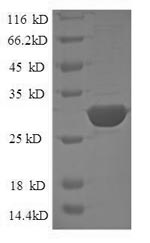The fusion tag N-terminal GST tag gene was added to the gene sequence corresponding to the E.coli of the human CD24 protein to form the recombinant DNA. The recombinant DNA was cloned into the expression vector and then transformed into the E.coli for expression. Following purification, the product is the recombinant human CD24 protein carrying N-terminal GST tag. The SDS-PAGE assessed the purity of this recombinant CD24 protein up to 90%. It had an apparent molecular weight of approximately 30 kDa. This recombinant CD24 protein may be used in CD24-associated immunology research.
CD24 is a gene providing instructions for making a protein named signal transducer CD24 and belongs to CD24 family. CD24 is a signal-transducing molecule on the surfaces of most human B cells that can modulate their response to activation signals by antagonizing IL-induced differentiation into antibody-forming cells and inducing proliferation in combination with signals generated by Ag receptors. Emerging evidence indicated that CD24 suppresses the germ cell program and promotes an ectodermal rather than mesodermal cell fate in embryonal carcinomas.






